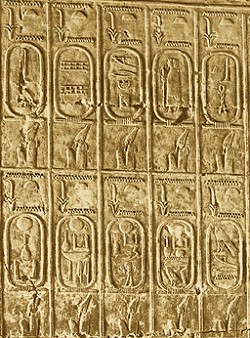
Am Ende der Ptolemäerzeit regierten Kleopatra VII. und ihr Bruder Ptolemaios XIII. anfangs zusammen. Als Julius Caesar 47 v. Chr. nach Alexandria kam, wurde Ptolemaios umgebracht. Nachdem Kleopatra Caesar einen Sohn, Caesarion, geboren hatte, verbündete sie sich 41 v. Chr. mit Marcus Antonius. Er war als 'praefectus equitum' mit einer Expedition nach Ägypten gekommen, die von dem syrischen Vizekönig Aulus Gabinius angeführt wurde. Nach einer Propagandaaktion gegen Marcus Antonius durch Octavian 32 v. Chr. erklärte der römische Senat Ägypten den Krieg und kurz darauf folgte die Schlacht von Aktium (2. September 31 v. Chr.) und die Besetzung Alexandrias (1. August 30 v. Chr.). Kleopatra und Marcus Antonius begingen Selbstmord, und Octavian (der spätere Augustus) ergriff die Macht, indem er sich zum Pharao erklärte; zu diesem Zeitpunkt beginnt offiziell die Römerzeit. Seine Herrschaft dauerte bis 14 n. Chr. Zu Augustus' Nachfolgern gehören Tiberius, Caligula, Claudius und Nero. Die Kaiser herrschten von Rom und nicht von einer ägyptischen Residenz aus. 69 n. Chr. wurde der General Vespasian von seinen Legionen zum Kaiser ausgerufen; bevor er sich auf den Weg nach Rom machte, befragte er das Orakel des Sarapis. Unter Trajan (98-117 n. Chr.) wurde ein Kanal zwischen dem Nil (in der Nähe von Bubastis) und dem Roten Meer, den Necho II. begonnen und Darius vollendet hatte, wiedereröffnet. Hadrian (117-138 n. Chr.) besuchte selbst Ägypten; während seines Aufenthaltes ertrank sein Freund Antinoos im Nil. Er wurde unverzüglich vergöttlicht und die Stadt Antinooupolis wurde nach ihm benannt. 139 n. Chr., während der Regierung des Antoninus Pius, fiel der heliakische Frühaufgang des Sirius mit dem ägyptischen Neujahr zusammen, ein Phänomen, das nur alle 1460 Jahre stattfand. Es wurde auf Münzen verzeichnet. Es ist ein wichtiger Faktor bei der Berechnung von Daten und Chronologien. Die römischen Kaiser galten als Pharaonen; sie wurden auf Tempelwänden abgebildet und schrieben ihre Namen in Kartuschen; da sie aber keinen 'Geburtsnamen' und 'Thronnamen' hatten wie die ägyptischen Pharaonen (den 'Sohn des Re'-Namen und den 'König von Oberägypten und Unterägypten'-Namen), wurde ihr echter Name in die 'Sohn des Re'-Kartusche gesetzt (in die die früheren Pharaonen ihren Geburtsnamen geschrieben hatten); in der anderen Kartusche (in die die früheren Pharaonen ihren Thronnamen geschrieben hatten) enthielt lediglich das Wort 'Kaisar' oder manchmal 'Autokrator Kaisar'. Die römischen Kaiser fügten Bauten zu bestehenden Tempeln hinzu oder begannen neue. Der Tempel von Esna beispielsweise wurde unter Claudius begonnen. Gleichzeitig begann man, die Tempel stark zu besteuern. Viele Obelisken wurden von Ägypten nach Rom und anderen wichtigen Orten des Römischen Reiches gebracht. Von Anfang an ernannte Rom einen Präfekten, der sich um die täglichen Angelegenheiten zu kümmern hatte. Es folgte die unverzügliche Ausbeutung des Landes - Ägypten wurde zur bloßen Kornkammer des Römischen Reiches. Alexandria wurde mehrere Male infolge der Niederschlagung von Rebellionen durch die Römer zerstört und geplündert. Zu jener Zeit faßte das Christentum in Ägypten Fuß; die Verkünder der neuen Religion wurden von der unterdrückten Bevölkerung willkommen geheißen. Die altägyptische Kultur und Religion verloren schnell an Boden. Die noch nicht von koptischen Mönchen zerstörten Tempel wurden im Verlauf des vierten Jahrhunderts geschlossen und verfielen. Der letzte in Hieroglyphen geschriebene Text wurde 394 n. Chr. auf der Insel Philae geschrieben. Die Bibel wurde bald in die damalige Volkssprache übersetzt, wofür das griechische Alphabet und einige demotische Zeichen verwendet wurden. So entstand das Koptische. 204 n. Chr. fand in der Regierungszeit des Septimius Severus die erste großangelegte Christenverfolgung im gesamten Römischen Reich einschließlich Ägyptens statt; eine weitere geschah unter Diocletian (284-305 n. Chr.). Erst unter der Regierung Konstantins (324-337 n. Chr.) wurde die Lage der Kopten leichter. Sobald das Römische Reich 395 n. Chr. in eine westliche und eine östliche Hälfte geteilt worden war, endete die römische Herrschaft über Ägypten - es wurde nun von Byzanz aus regiert.